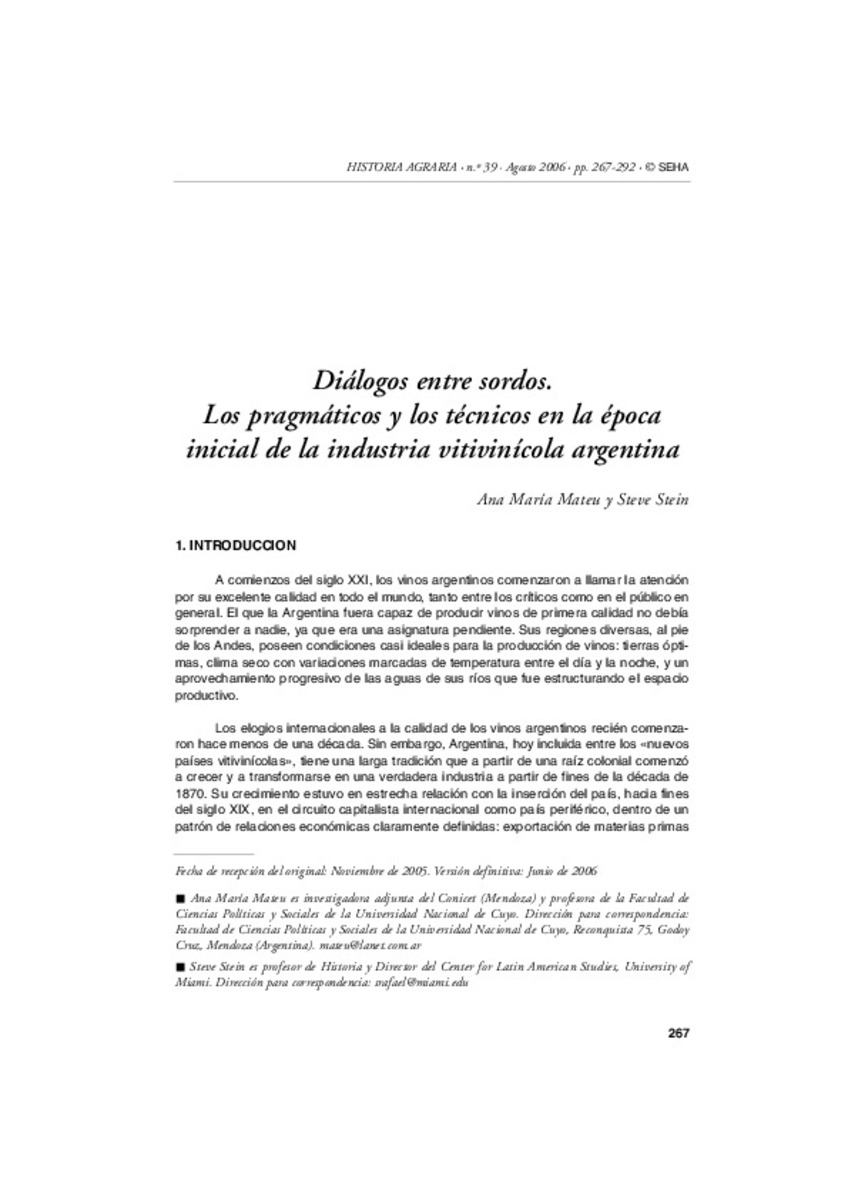Mostrar el registro sencillo del ítem
Diálogos entre sordos. Los pragmáticos y los técnicos en la época inicial de la industria vitivinícola argentina
| dc.contributor.author | Mateu, Ana María | |
| dc.contributor.author | Stein, Steve | |
| dc.date.accessioned | 2016-07-13T09:26:17Z | |
| dc.date.available | 2016-07-13T09:26:17Z | |
| dc.date.issued | 2006-08 | |
| dc.identifier.issn | 1139-1472 | |
| dc.identifier.uri | http://hdl.handle.net/10234/161668 | |
| dc.description.abstract | This article analyses the permanent conflict between quantity and quality that has characterized the Mendoza wine industry since the final decades of the nineteenth century. The authors confront the practices of the industry and state policies with the critiques of renowned specialists of the era. The observations of this group are striking, as much for their clear and careful analysis as tor the tenacity with which they were ignored by industry leaders and public officials. Although this study focuses on the formative period of Argentina wine production (1870M1930), it is significant that the recommendations of these early observers, directed at making competitive one of the most important industrial centres of the country, continued to be insistently repeated by succeeding generations of critics throughout most of the twentieth century. And with equal insistence, they appear to have been almost completely ignored, or more Iikely rejected, by Industry leaders. This resistance to a model committed to quality over quantity was closely related to the developing consumer market, made up largely of Southern European immigrants with little or no concern for the quality of their wines. The owners of large wineries also bear significant responsibility; interested above all in amassing easy profits quickly, they raced forward, often copying models from abroad that were not appropriate for the healthy development of the wine industry. Finally, the state played an important role by failing to solidly support this sector by encouraging policies designed to produce balanced development. In this initial stage, vineyards, wineries, investment capital, workers and consumers expanded so rapidly that both the Argentine wine producers and the state, as collector of taxes from the industry, ended up blinded by their euphoria; they saw neither the problems of the industry nor the ways It could have achieved long-term sustainable progress | ca_CA |
| dc.format.extent | 26 p. | ca_CA |
| dc.format.mimetype | application/pdf | ca_CA |
| dc.language.iso | spa | ca_CA |
| dc.publisher | Sociedad Española de Historia Agraria (SEHA) | ca_CA |
| dc.relation.isPartOf | Historia agraria: Revista de agricultura e historia rural, nº 39, p. 267-292 | ca_CA |
| dc.rights | © SEHA | ca_CA |
| dc.rights.uri | http://rightsstatements.org/vocab/InC/1.0/ | * |
| dc.subject | Vino | ca_CA |
| dc.subject | Wine | ca_CA |
| dc.subject | Wine industry | ca_CA |
| dc.subject | Argentina | ca_CA |
| dc.title | Diálogos entre sordos. Los pragmáticos y los técnicos en la época inicial de la industria vitivinícola argentina | ca_CA |
| dc.type | info:eu-repo/semantics/article | ca_CA |
| dc.rights.accessRights | info:eu-repo/semantics/openAccess | ca_CA |
| dc.relation.publisherVersion | http://www.historiaagraria.com/numero.php?n=39 | ca_CA |







